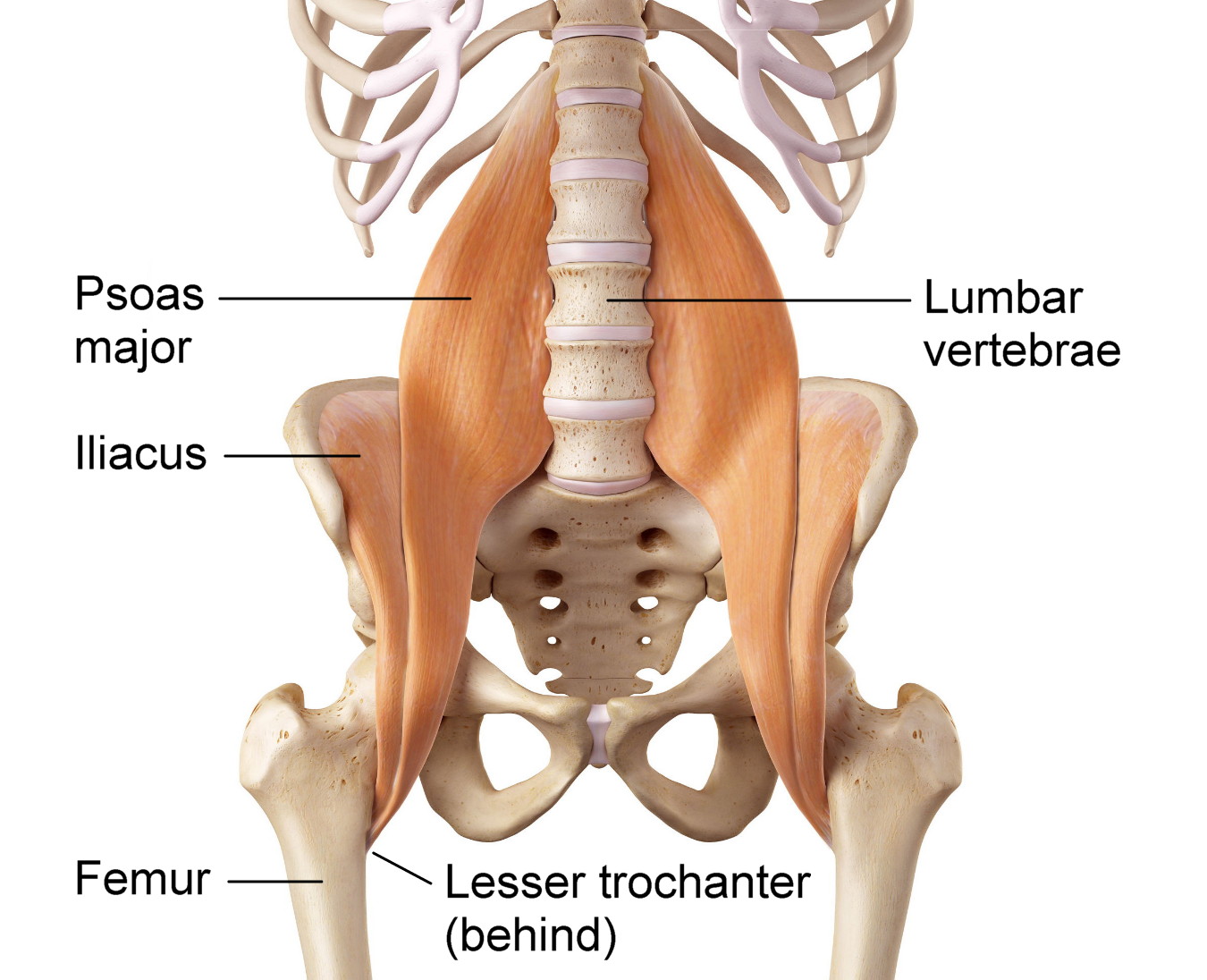Why You Can’t Release Your Tight Psoas Muscle With Stretching
Your physical therapist, chiropractor, or yoga teacher might have told you that you have a tight psoas muscle, and they may have taught you stretching exercises to release it.
While they’re probably right—having a tight psoas is a very common problem—static stretching has little to no lasting effect on the level of tension in the psoas muscle.
As a former ballet dancer, I used to have an extremely tight psoas muscle, which caused me to have back pain, back spasms, and functional leg length discrepancy. In the course of my training to become a Clinical Somatic Educator, I learned the technique of pandiculation, which allowed me to finally release years of built-up tension in my psoas muscle. As I practiced Clinical Somatics exercises daily, my psoas muscle gradually lengthened, my back pain and spasms disappeared, and my hips evened out.
I’ll explain why stretching doesn’t work later in the post, but first I’m going to explain what the psoas muscle is and what problems a tight psoas muscle can cause.
What is the psoas muscle?
The psoas muscle, formally called the psoas major, is a very important core muscle. The psoas attaches the lumbar vertebrae to the lesser trochanter, near the head of the femur.
The psoas muscle is often grouped together with the iliacus muscle, and together they’re referred to as the iliopsoas. Due to its location deep within the core of the body, the psoas is difficult to feel with your hands and to sense internally.

What does the psoas muscle do?
The psoas muscle performs several important actions:
-
The psoas flexes the hip, so when it contracts it brings the knee in toward the stomach. If you spend a lot of time sitting, your psoas is likely tight as a result of spending so much time in a shortened state.
-
The psoas laterally rotates the hip, allowing you to stand like a ballet dancer with your feet pointed outward. Dancers often have a great deal of tightness in their psoas muscle.
-
The psoas adducts the hip, bringing the leg in toward the center of the body. If you squeeze your knees together, you’re engaging your adductors.
-
Because of its attachments to the lumbar vertebrae, the psoas muscle contributes to lateral tilting of the pelvis (hiking the hips up one at a time) and lateral flexion of the spine (bending the spine to one side).
What are the symptoms of a tight psoas muscle?
You may have heard of “iliopsoas syndrome.” That’s just a convenient way to refer to the symptoms that often result from chronic tightness in the iliopsoas:
- Tension and pain in the lower back, hips, buttocks, pelvis, or groin
- Lower back spasms
- Snapping hip syndrome
- Radiating pain down the leg
- Sciatica
- Lumbar disc problems
- Limping
- Functional leg length discrepancy
- Idiopathic scoliosis
- Hyperlordosis
- Instability in the core of the body
- Limited flexibility in the lower back
Why does the psoas muscle get tight?
It’s safe to say that most people, from office workers to professional athletes, have some chronic tightness in their psoas muscle. In addition to overuse (like athletic training) and limited movement (like sitting down all day), physical and emotional trauma have been linked to psoas tension.
Due to its location deep within the core of the body, the psoas muscle instinctively tightens up when we feel stress or fear. For some people, learning to let go of the tension in their psoas is an intense emotional process.
Why stretching doesn’t work
It’s widely believed that you can release a tight psoas muscle by stretching, but static stretching actually does very little to release involuntary muscle contraction.
The resting level of tension in our muscles is set by our nervous system. Over time, as a result of repetitive movements and stress, our nervous system learns to keep certain muscles tight. While static stretching temporarily lengthens muscles by reducing the activity of our stretch reflex, the effect is short-lived. Our muscles typically start tightening up within a few hours as our stretch reflex regains normal function.
You can learn more about the stretch reflex and why stretching doesn’t work in these two posts: What is the Stretch Reflex? and Why Stretching Doesn’t Work, and in this video: Why Stretching Doesn’t Work.
As a ballet dancer, I stretched for at least 30 minutes a day for 17 years—and my psoas was still extremely tight! During my professional training to become a Clinical Somatic Educator, I stopped stretching altogether and started practicing Clinical Somatics self-pandiculation exercises. The process of releasing my psoas with pandiculation was truly life-changing. It felt like I was waking up a part of my body that I had never felt before.
Pandiculation: The most effective way to release a tight psoas muscle
The only way to change the resting level of muscle tension being set by the nervous system is through active movement.
Pandiculation is a neuromuscular re-education technique developed by Thomas Hanna, the founder of Clinical Somatic Education. Pandiculation involves gently contracting and releasing muscles in certain ways so that accurate feedback about the level of tension in the muscles is sent to the nervous system.
Pandiculation naturally resets the level of tension in our muscles, alleviating muscle and joint pain, retraining posture and movement patterns, and preventing recurring injuries.
You can read about recent research on pandiculation in this article.
Keep in mind—your tight psoas muscle isn’t the only problem
It’s important to understand that tightness in a single muscle is never the sole cause of a painful condition or movement limitation.
Every movement we make involves many muscles working together, so every pattern of tension that we develop involves chronic tightness in a number of muscles. You must work with the entire pattern of tension in order to relieve your problem. While we teach a highly effective psoas release exercise in Clinical Somatics, we still always work with the entire pattern of tension.
You can learn how to address full-body patterns of tension that involve the iliopsoas in this article.
The most effective Clinical Somatics exercises for releasing your tight psoas
If you’re interested in learning Clinical Somatics exercises to release your tight psoas muscle, you should start with the Level One Course. The course includes the iliopsoas release exercise, as well as other exercises that relieve tightness, pain, and muscular imbalance in the back and hips. You can read testimonials about how Clinical Somatics releases tension and relieves chronic pain here.
The following exercises from the Level One Course are the most effective exercises for releasing a tight psoas and the associated patterns of muscle tension.
LEVEL ONE COURSE
Arch & Flatten: This exercise allows you to release and regain control of the lower back and abdominal muscles, improving the alignment of the pelvis and lower back. Most people who have a tight psoas also have tight lower back muscles.
Back Lift: This exercise releases the muscles of the back, which are typically tight in people who have a tight psoas.
Arch & Curl: This exercise releases the lower back and abdominal muscles, and is a necessary warm-up for the Iliopsoas Release, which involves a Curl.
Side Curl: This exercise releases the obliques, quadratus lumborum, and psoas, which together laterally tilt the pelvis and laterally flex the spine.
One-Sided Arch & Curl and Diagonal Arch & Curl: Like the Arch & Curl, these exercises allow you to release and regain control of the lower back and abdominal muscles. These exercises have the added bonus of focusing on one side at a time, allowing you to address imbalances in your muscular patterns.
Iliopsoas Release: The previous exercises have worked with releasing the psoas gently, and now you’re ready for this most important exercise! The Iliopsoas Release is the movement that most directly works with releasing a tight iliopsoas, and it can feel intense and challenging. There are three versions of this exercise, and it’s important that you are able to do Version 1 comfortably before moving on to Version 2, and so on.
Hip Slides: This exercise allows you to regain voluntary control of the psoas by working with lateral pelvic tilt and lateral bending of the spine.
Hip Rotation: This exercise releases the psoas by working with both internal and external rotation of the hip.
Click here to learn more about the Level One Course.
Recommended reading:
The Pain Relief Secret: How to Retrain Your Nervous System, Heal Your Body, and Overcome Chronic Pain by Sarah Warren, CSE
Somatics: Reawakening the Mind’s Control of Movement, Flexibility and Health by Thomas Hanna

